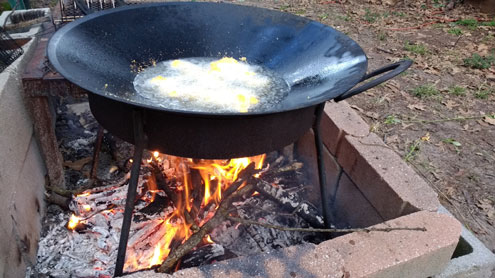Having been raised in a fishing family, my familiarity with frying fish goes back a long, long way. As a youngster growing up on a chicken farm in Red River County, I learned at a very young age what is involved in creating that “perfect” fish fry.
About every 9 weeks, my dad sold the 14,000 fryer chickens he raised and declared a 4-day holiday. We went fishing across the Red River up in Oklahoma to a little lake we called Long Log Lake. I later discovered the lake’s proper name was Long Lost Lake. But it was full of logs and provided ideal habitat for channel catfish.
Actually it was loaded with catfish. I don’t remember us catching any really big ones, but fish weighing between 1.5 and 4 pounds were plentiful and easy to catch.
We set trotlines back in those days and our goal was to get camp set up in the afternoon and the lines baited in time to catch that first “mess” of catfish for the evening meal. About all we brought on these camping/fishing trips for the evening meals was lard, corn meal, salt pepper, potatoes, catsup, onions, light bread and canned pork and beans. We depended upon the lake’s plentiful population of channel catfish for the main course and I don’t remember us ever not having an abundance of crispy fried fish.
Dad used a 14-inch cast iron skillet for frying fish and he did his cooking on a Coleman stove. I remember him instructing us as to the proper way to fry fish. “You have to have the grease (lard back then) really hot. When it’s hot enough to ignite a kitchen match, it’s ready.” He would always cut off a tiny bit of fish and drop it into the oil. He was listening for that “sizzle” that insured the grease was hot enough.
Since those early years, I have enjoyed many fish fries, some prepared over a wood fire by Cree Indians on islands on remote fly in Saskatchewan lakes and many in my own backyard as well as countless other places. There is something very special about frying fish that brings people together. Frying fish is really very simple and easy but there are a few things that must be done correctly. The number one rule is to get the grease hot enough. The match test or the “sizzle” test work well but until one masters these little tricks, a good high temperature thermometer is a good investment.
You want your grease heated up to 375 degrees before that first fish fillet goes in. This will insure the batter stays on the fillet. If the grease it not hot enough, you’ll see the corn meal begin to fall off the fillet. I prefer a mixture of 75 % corn meal and 25% flour when frying fish. The flour seems to help bond the corn meal to the fillets. I usually add my favorite dry seasonings to the batter but there are excellent pre-mixed batters on the market.
It’s important to pay close attention to the fillets as they are frying. Some fillets will invariably be thicker than others. It is usually necessary to remove the thinner pieces as they become crispy. And I do mean crispy, nothing worse than a fish fillet that is soggy and not thoroughly cooked. Rather than using thick pieces of fish, I much prefer cutting the fillets into smaller pieces that fry quicker.
During the cooking process, it’s also necessary to keep an eye on the temperature of the grease. Adding several chilled fillets will invariably drop the temperature. I add the fillets one at a time and if the accompanying “sizzle” is not present, it’s necessary to give the grease a bit more time to reach that 375 degree mark.
There is a couple schools of thought when it comes to frying fish. Some like to “deep fry” in a pot big enough to handle a couple gallons of cooking oil. This method is best if you are cooking for a large group. The other is frying a skillet or wok with only an inch or two of grease. This is the method I use most often unless I am cooking for a large group.
I have a fire pit in front of my little “hunting cabin” that is situated in the trees behind my house. I keep a good supply of dry wood on hand and do a lot of my frying over the wood fire but, I also have a heavy duty two burner stove inside the building that I use frequently. My guests love setting around the cookfire and watching the fillets sizzle in my homemade wok that is fashioned from a John Deer plow disc.
I guess my childhood roots run pretty deeply because I still consider a big fish fry the ultimate reward of a successful fishing trip.

Hopefully this week’s column has inspired you to invite a few folks over to enjoy the bounty of your recent fishing trip (or the local fish market)! Just remember to get and KEEP that oil hot when frying fish and give the fillets enough time to become crunchy before you dip them out of the grease and place them on the paper towels to drain.
Luke’s book on hog hunting, Kill to Grill, the Ultimate Guide to hunting and cooking Wild Hogs is available through Amazon or www.catfishradio.com.